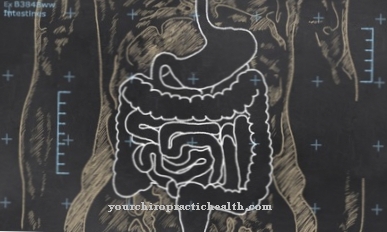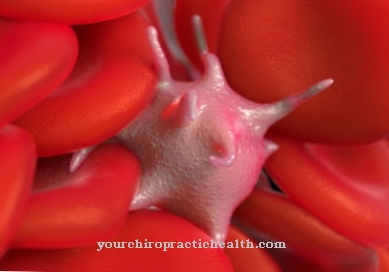The Rotary motion comes as movement on the human body, etc. on the foot and forearm. It plays an important role in walking and in important everyday hand activities.
What is the rotary motion?

On the foot, the movement takes place in the anterior chamber of the lower ankle, which is formed by three tarsal bones. One of the three, the navicular bone, rotates around the other two during this movement, so that the inner edge of the foot is turned upwards. This process is purely descriptive. A pure rotation cannot be actively carried out in this joint because the executing muscles are not able to do so due to their course. Other movement components are therefore always coupled to the rotary movement. By fixation of the two tarsal bones close to the body, isolated rotation can be performed passively, for example during movement examinations.
The rotational movement on the upper limb is movement between the two forearm bones. The spoke rotates around the ulna so that the two bones are parallel to each other in the end position. With the counter-movement, the pronation, a strong crossover occurs. By coupling the wrist and the carpal bones, the hand is carried along by the rotation of the forearm bones. When turning, the palm increasingly points towards the body; when pronating, the back of the hand points towards the body.
Function & task
The rotation of the foot is involved in all free movements that are directed inward. It is an important component of the swing leg phase. The stronger the orientation towards the center of the body and the faster the execution, the greater its importance. Such activities occur in many sports activities.
A typical example are the movements in martial arts, where the aim is to get the opponent off the feet with a swing of the leg or a diagonal kick. In football, a pass or a flank with the inner instep is very much characterized by the rotation and the development of strength of the executing muscles, the supinators. The spin that the ball gets is mainly a transfer of the energy of the supinatory foot position to the ball movement.
All activities of the hand directed towards the body, which take place in the upper and front area, are only functionally possible through the involvement of the rotary movement. Their interaction with the adduction and flexion in the shoulder joint and the flexion in the elbow allow the hand to reach almost any point on the head and upper torso.
Perhaps the most important activity that is carried out is eating. But other actions in everyday life, such as washing your hair, blowing your nose, scratching your head or neck, as well as picking up objects and pulling them towards your body, are characterized by these movement components.
In sport, arm movements that are carried out from the bottom outside to the top inside are often linked to a rotation. Characteristic motion sequences with these components are the forehand strokes of the racket sports tennis, squash and badminton. In badminton in particular, the rotation gives the decisive movement impulse for the acceleration of the ball. The same trajectory of movement with a strong supination component of the hand can also be seen in boxing when uppercut is struck. The biceps as flexor and strongest supinator is used in its full strength.
All swinging movements of the arm and hand above the head include the rotation as a pre-stretching component for the following punching or throwing movement, such as throwing a stone or slamming in volleyball.
You can find your medication here
➔ Medicines for painIllnesses & ailments
As with all movements, rotation can be affected by decreased muscle activity or other processes that limit the range of motion. The effects on vital functions such as eating and walking are often blatant. The affected people can no longer perform these movements completely or not at all and thereby lose their independence.
In addition to the systemic diseases such as muscular dystrophies or amyotrophic lateral sclerosis, there are often special injuries and ailments that hinder the functions.
In the foot, these can be fractures in the area of the tarsal bones or ligament injuries. They often arise from unfavorable movements as a result of the action of external forces. A typical injury mechanism is the so-called supination trauma, in which the foot bends inward, which often leads to fractures and tears of the outer ligaments.
Herniated discs or peripheral nerve lesions can lead to so-called dorsiflexion weakness. The rotary movement is affected when the tibial nerve is damaged. A special form of influencing the execution of movements on the foot typically arises as a result of a stroke. Hemiplegia develops on the affected side with spasticity of the leg with a strong tendency to stretch and supinate. When walking, the leg is guided very strongly inwards via a circular movement in the hip joint and the foot cannot be properly placed. The result is the so-called Wernicke-Mann gait pattern.
In the upper extremity, damage to arm nerves can negatively affect the functions of the hand. In addition to herniated discs in the cervical spine, peripheral damage to the median or radial nerve is often responsible for negative effects on the rotational movement.
Broken bones in the forearm have a direct impact on the mobility of the forearm bones. Typical injuries of this type are wrist fractures with involvement of the ulna and radius and the fracture or dislocation of the proximal radial head.
The rotational movement as a rotational movement is not possible even after medical treatment, or not allowed until the bone has completely consolidated.




























.jpg)